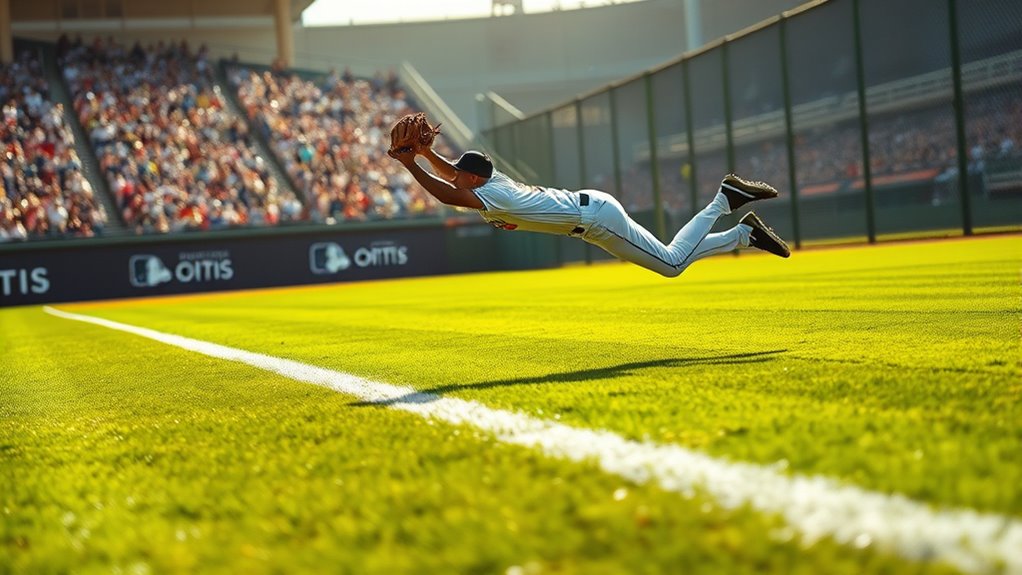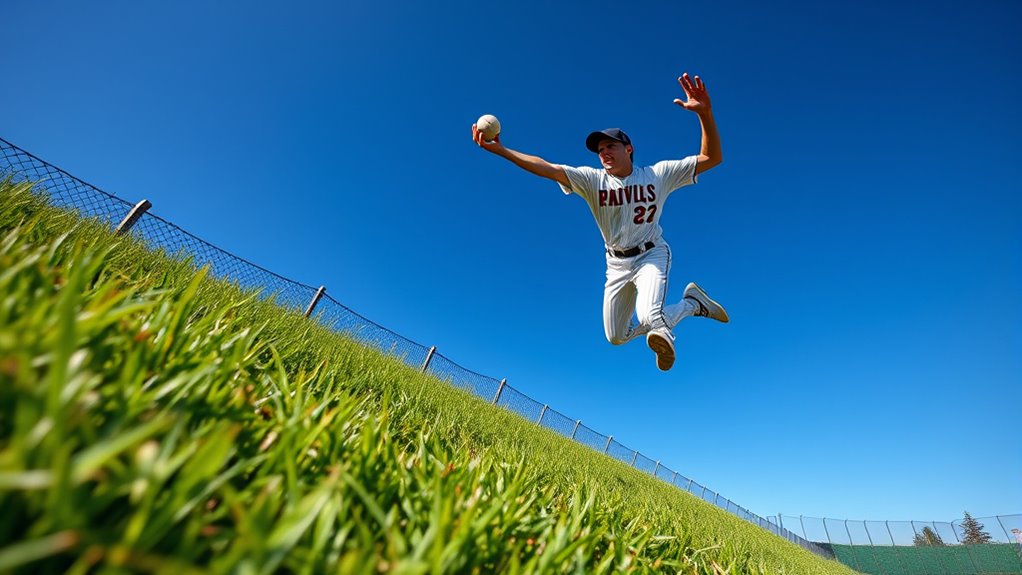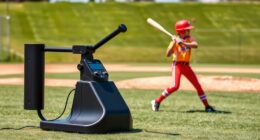To master outfield play, focus on accurately judging ball trajectory by observing spin and wind, so you can position yourself early. Use quick glove techniques, keep your body balanced, and extend fully when making catches, especially on diving and fence leaps. Stay alert and adjust your stance based on the hitter and ball type. With practice, you’ll improve your timing, confidence, and ability to turn difficult plays into routine outs. Continue exploring these tips to elevate your game even further.
Key Takeaways
- Study ball trajectory early, considering spin and wind, to position accurately for diving catches and fence leaps.
- Keep gloves low, extended, and ready, with eyes locked on the ball for reliable catches during dives and leaps.
- Adjust positioning proactively based on hitter tendencies and hit distance to optimize response and coverage.
- Practice precise footwork and timing to maximize leap height, control, and secure catches near the fence.
- Develop consistent reading, glove techniques, and movement to elevate overall outfield performance and game impact.

Mastering the outfield is essential for any player looking to excel in baseball. Your ability to judge ball trajectory accurately can mean the difference between a routine out and a game-changing play. When a ball is hit high and deep, you need to anticipate its path quickly, considering factors like spin, wind, and the angle of contact. By reading the ball’s trajectory early, you position yourself precisely, giving you a better chance to make a clean catch. Your glove techniques come into play here—how you position your glove, angle it, and move your body can considerably influence your success. Always keep your glove low and ready, with your eyes locked onto the ball, and use quick, controlled movements to intercept it. Developing reliable glove techniques allows you to transform difficult catches into routine plays, especially when tracking sharply hit grounders or fly balls that are veering toward the fence. Additionally, understanding the importance of outfield positioning can help you optimize your chances of catching difficult hits and covering more ground efficiently.
When a ball is hit toward the outfield, your quick decision-making and positioning are essential. Maintaining a balanced stance, with your weight on the balls of your feet, helps you react swiftly. As you read the ball’s trajectory, you must decide whether to take a step forward or back, or to shift left or right. Proper positioning before the pitch is key—stand slightly deeper if you anticipate a long fly, or move closer if the hitter tends to hit shorter, quicker balls. This proactive stance ensures you’re always ready to adjust, preventing unnecessary lunges or overextensions. When it’s time to make a diving catch, your glove techniques are vital. You want to keep your glove out in front of you, fingers pointed upward, and extend fully to maximize your reach. A proper dive isn’t just about leaping; it’s about controlled, precise movements that allow you to land safely and secure the ball.
Fence leaps demand similar focus. As you approach the outfield wall, watch the ball’s trajectory with laser focus, timing your jump so you can reach it at the highest point. Your glove techniques in these moments involve reaching out early, extending fully, and ensuring you secure the ball against the fence. Practice proper hand positioning and footwork to maximize your leap and minimize the risk of overextending or missing the catch. The key is to stay alert, read the ball early, and use your glove efficiently to make those spectacular catches that can save your team from extra bases or home runs. Mastering these skills requires consistent practice, keen observation of ball trajectories, and flawless glove techniques—skills that turn good outfielders into outstanding defenders.
Frequently Asked Questions
How Do Outfielders Improve Their Reaction Time During Games?
To improve your reaction time during games, focus on enhancing your reaction speed through consistent visual training. Practice tracking fast-moving balls and anticipating plays to sharpen your instincts. Stay alert and develop quick decision-making skills by simulating game scenarios during practice. By regularly exercising your visual perception and reaction speed, you’ll become more responsive and confident when tracking fly balls or making quick catches, ultimately boosting your overall outfield performance.
What Are the Best Drills for Enhancing Outfield Footwork?
To improve your outfield footwork, focus on specific drill variations and footwork drills that sharpen agility and speed. Incorporate ladder drills, cone shuffles, and quick-step exercises to boost your responsiveness. These drills help you move efficiently along the outfield and get into position faster. Consistent practice of these footwork drills will enhance your agility, allowing you to track fly balls better and make more effective catches during games.
How Can Outfielders Anticipate Fly Ball Trajectories More Accurately?
To anticipate fly ball trajectories more accurately, you should study fly ball physics and focus on trajectory prediction. Watch how environmental factors like wind, sun, and stadium layout affect the ball’s path. Keep your eyes on the ball from the moment it’s hit, and use cues like spin and speed to gauge its trajectory. Practice tracking different hit types regularly to sharpen your instinct and improve your reaction time.
What Equipment Helps Prevent Injuries During Diving Catches?
To prevent injuries during diving catches, you should use equipment like gloves with advanced glove technology that offers better grip and padding. Protective gear such as padded elbow and knee pads, along with a lightweight helmet, can shield you from impacts. This gear helps absorb shocks and reduces the risk of cuts, bruises, or fractures, allowing you to focus on making those impressive catches without fear of injury.
How Do Outfielders Communicate Effectively With Teammates?
You communicate effectively with teammates by using clear verbal cues and non-verbal signals. Call out plays loudly so everyone knows their responsibilities, and use hand signals or eye contact to coordinate quickly. This helps prevent collisions and guarantees smooth plays. Practice these methods regularly to build trust and understanding, making your outfield more coordinated and responsive during game situations.
Conclusion
Mastering the outfield isn’t just about talent; it’s about hustle, sharp positioning, and fearless dives. Keep practicing those leaps, anticipate plays, and stay alert—your effort pays off. Remember, “practice makes perfect,” so stay committed to refining your skills. With dedication and the right mindset, you’ll become the player everyone counts on in clutch moments. Keep pushing your limits, and you’ll find out just how much you can achieve out there.









